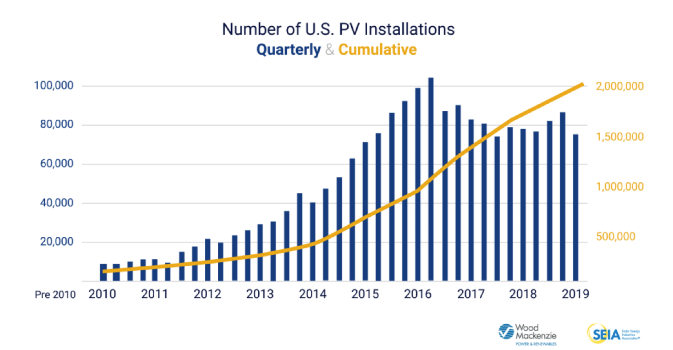Toward 100% Clean Energy: Two Million Solar Strong and Growing
Today, IREC proudly joins the collective voice of advocates and industry celebrating a milestone we have worked for 37 years to witness: two million solar installations now in the U.S. What better timing than in a year when children and governors, presidential candidates and corporate CEOs are all making headlines about the urgency of climate change action.
We have worked in nearly every state to make a 100% clean energy future possible. And while there are many challenges still to face, the good news is that the critical need is finally in the American mainstream dialogue, along with exciting, viable solutions. And decision makers in nearly every state are listening.

Every week we read of newly announced climate goals - a tremendous step. But the question remains: what really has to happen to get from where we are today, proudly at two million solar installations, to three million and four, to where electric vehicles, energy storage, and energy efficiency are the norm.
4 Things That Have to Happen to Reach 100% Clean Energy
1. Planning for easy, fair, affordable connection to the grid
Integrating the currently installed capacity of solar into the grid is straightforward today in most states, but it becomes more challenging as installed solar increases. More renewables, i.e. solar and wind, means more intermittent resources. Add more electric vehicles, and we have a potentially large intermittent electric demand. Integrating and optimizing these clean energy technologies will require a new way of thinking about the electricity grid, and perhaps most importantly, electricity planning. Fully evaluating potential solutions will be key to avoiding costly mistakes and delays. Best practices can then be created and replicated, so more states can get ahead of evolving issues associated with the transition to increased clean energy.
2. Equitable accessible clean energy for all
The grid must not only work for high amounts of intermittent clean energy, but must be developed in an equitable way for all consumers. The clean energy economy will need to include those who cannot afford large capital purchases, such as their own rooftop solar, or the addition of energy storage, or demand response to manage high and low periods of energy production. IREC is expanding efforts to develop policies and programs that allow renters and other low- and moderate-income consumers to receive the benefits of solar and other clean energy technologies.
3. Protecting the security of the electricity grid
As more energy systems with software controls are connected to a central grid system, there will need to be a more concerted focus on cybersecurity. Consumer information, data sharing and privacy are other considerations. Ensuring grid security and adopting appropriate protections will be integral to the ability of new clean energy technologies to be connected with confidence.
4. Ensuring the workforce is prepared
Fortunately, in addition to addressing urgent climate and health concerns, meeting clean energy goals provides economic benefits and opportunities, through both energy savings and increased jobs. In 2017, 650,000 people worked with renewable energy generation technologies in the U.S., and 2.25 million spent some or all of their time working with energy efficiency technologies and services. As the percentage of clean energy grows, so too will the number of professionals who need to integrate renewable energy, energy efficiency and clean energy technologies into their work, across numerous industry sectors.
Cheers to #2MillionSolarStrong and growing!
About IREC
IREC is an independent national not-for-profit shaping a clean energy future since 1982, increasing access to sustainable energy and energy efficiency through fact-based policy leadership, quality workforce development and consumer empowerment. Through engagement in state regulatory proceedings, technical support to decision makers, advocates and industry, IREC drives scalable, foundational policy solutions and best practices integral to achieving 100 percent clean energy goals, including a workforce trained to support a clean energy economy. https://irecusa.org
Comments (0)
This post does not have any comments. Be the first to leave a comment below.
Featured Product

